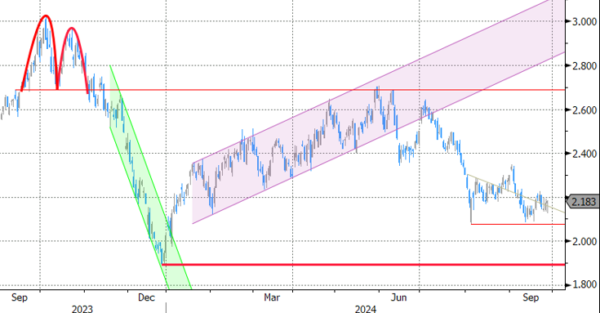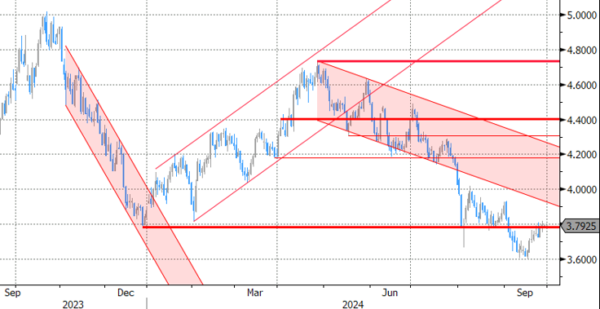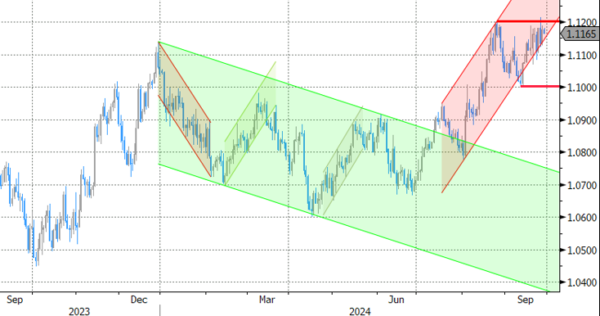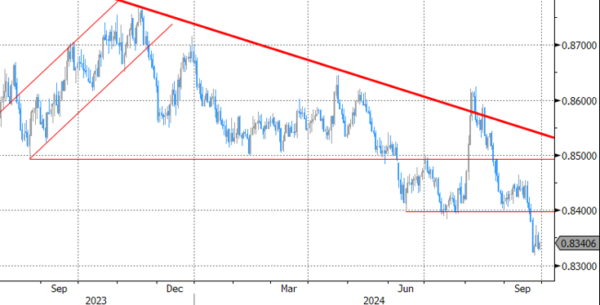Markets
A rising tide lifts all boats. Or in this case, a rising Chinese stock market lifts global risk sentiment. More fiscal spending, measures to stabilize the property sector, potential capital injections in the largest banks and forceful rate cuts are now also part of the toolkit announced earlier this week. European stock markets closed up to 2.35% (!) higher for the Eurostoxx50 with main US benchmarks extending their record race (+0.4%-0.6%) though closing off the day’s best levels. Most Asian stock markets show signs of some consolidation this morning, apart from China which adds another 5%-7% to an already record-week.
US eco data included a minor upward revision in the final Q2 print (3% Q/Qa), but especially consensus-beating durable goods orders (August) and lower weekly jobless claims (218k). Although second tier and coming ahead of PCE deflators (today) and ISM’s, ADP employment change and payrolls (next week) they did manage to swing the November Fed pendulum more into balance between a 25 bps and a 50 bps rate cut. Changes on the US yield curve ranged between +7 bps (2-yr) and -0.9 bps (30-yr). Lower oil prices partly help explain the strong curve shift with Brent crude prices dropping from $75/b to $71/b over the past two days. The move is linked to talk that Saudi Arabia is ready to abandon its unofficial $100/b oil price target. The FT reported that they would boost output from December 1st to regain market share. Bullish risk sentiment and lower oil prices balanced out interest rate support for the dollar. The greenback was going nowhere for most of the session and even lost some ground in the final stages of US trading. EUR/USD closed at 1.1177 from a start at 1.1133.
Today’s agenda contains first national European CPI indications for September (France, Spain, Belgium). Together with already released awful September PMI’s, they are the only input for the ECB in the short intermeeting period between September and October. PMI brough the possibility of a 25 bps rate cut back on the radar from a market point of view. We’re still in favour of a pause. When it comes to inflation numbers, ECB Lagarde at the press conference already “hedged” today and next month’s numbers by saying that they could fall somewhat further now before ticking up into year-end as energy-related base effects turn around. We’d be surprised though if markets pick up that nuance today, suggesting that lower inflation numbers could add to short term easing bets. Any potential euro weakness should remain short-lived going into next week’s big US eco week.
News & Views
Tokyo core inflation excluding fresh food printed at 2% Y/Y (from 2.4%) this month, matching the BoJ target. This move was mainly due to a reinstalment of measures to ease the cost of utilities (gas and electricity). The government measures are estimated to have reduced inflation by about 0.5%. A more strict core measure, excluding fresh food and energy was unchanged at 1.6%. Tokyo CPI data are seen as a good pointer for the national figure that will be released later next month. The October CPI reports are more important for BoJ policy setting as they might include price adjustments at the start of the fiscal second half of the year and give an indication on the degree that corporates are passing through the cost of higher wages. The Japanese yen didn’t respond to the inflation data, but suffered a setback (USD/JPY 146.50 from 145) after BoJ easing advocate Takaichi made it to the LDP leadership contest runoff (facing Ishiba).
The Bank of Mexico for the second consecutive meeting lowered its policy rate by 25 bps to 10.50%. Vice governor Jonathan Heath vote for an unchanged decision. The bank was mildly constructive in the inflation outlook going forward. Annual headline inflation decreased from 5.57% in July to 4.66% in the first fortnight of September. Core inflation continued trending downwards(3.95% Y/Y). It estimated that, although the outlook for inflation still calls for a restrictive monetary policy stance, its evolution implies that it is adequate to reduce the level of monetary restriction. The forecasts for headline and core inflation were revised slightly downwards for some quarters in the short term. Headline inflation is still expected to converge to the target in the fourth quarter of 2025. The Mexican CB targets 3.0% +/- a 1.0% tolerance band. The Mexican peso which traded in the defensive since April but came off the early September lows recently, closed yesterday’s session little changed near USD/MXN 19.63.
Graphs
GE 10y yield
The ECB cut policy rates by 25 bps in June and in September. Stubborn inflation (core, services) make follow-up moves less evident. We expect the central bank to stick with the quarterly reduction pace. Disappointing US and unconvincing-to-outright-weak EMU activity data dragged the long end of the curve down. The move accelerated during the early August market meltdown.
US 10y yield
The Fed kicked off its easing cycle with a 50 bps move. It is headed towards a neutral stance now that inflation and employment risks are in balance. Conservative SEP unemployment forecasts risk being caught up by reality and with it the dot plot (50 bps more cuts in 2024). We hold our call for two more 50 bps cuts this year. Pressure on the front of the curve and weakening eco data keeps the long end in the defensive for now as well.
EUR/USD
EUR/USD moved above the 1.09 resistance area as the dollar lost interest rate support at stealth pace. US recession risks and bets on fast and large rate cuts trumped traditional safe haven flows into USD. An ailing euro(pean economy) only briefly offset some of the general USD weakness. EUR/USD’s dollar-driven ascent is nearing resistance around 1.12 again.
EUR/GBP
The BoE delivered a hawkish cut in August. Policy restrictiveness will be further unwound gradually on a pace determined by a broad range of data. The strategy similar to the ECB’s balances out EUR/GBP in a monetary perspective. But the economic picture is increasingly diverging to the benefit of sterling. EUR/GBP succumbed to horrible European September PMI’s. Support at 0.84 broke and brings the 2022 low (0.8203) on the radar.


















